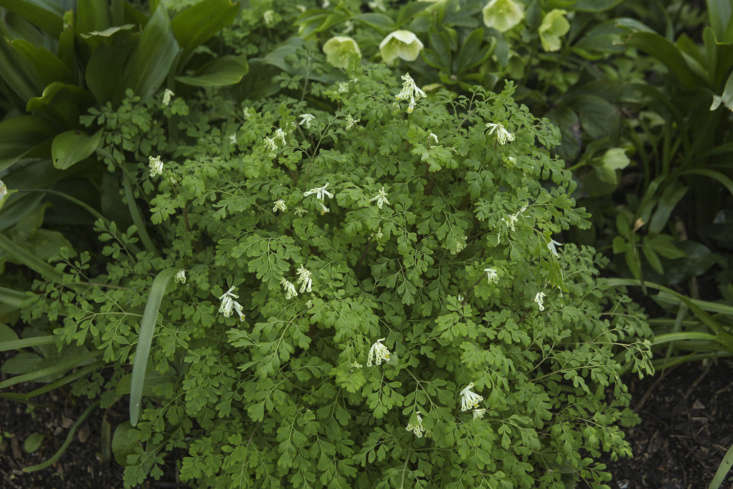Corydalis, Corydalis: “Bird in a Bush”
Shaped like the head of a crested lark (according to the ancient Greeks), corydalis flowers have a flitting, temporary look. They come and go all summer but the evergreen, filigree foliage is an indication of the plant’s permanence: once it chooses your piece of wall, gravel or shady patch, you’ve got it for good.
Photography by Jim Powell, for Gardenista.

Common names for corydalis include fumewort and yellow fumitory, although it is only distantly related to fumitory (Fumaria) within the Papavereae family. It bears a passing resemblance to bleeding hearts or fern, in its leaves. Flowers aside, the finely traced foliage of corydalis makes this a good ground cover plant. There are two main types, those that spread mainly by tubers, for instance C. solida and the seed propagating types, such as C. cheilanthifolia and famous yellow fumitory, Corydalis lutea.
Apparently people do sow yellow fumitory from seed but usually it just arrives. The white version—C. ochroleuca—is a more cautious choice, its neutrality making it a good companion to almost anything.

The other bright yellow corydalis, C. cheilanthifolia, is more dramatic, grown for its fern-like foliage and 8-inch spires of flowers. It spreads by seed and its leaves, tinged bronze in spring, make a good contrast in a woodland carpet.

Although corydalis is said to prefer shade and moisture, this is belied by its habit of seeding in crevices, in full sunshine. Like foxgloves, on close terms with walls and cracks in paving, it is the drainage that is most important, and a temperate climate (it is hardy to USDA zone 5).

Corydalis solida has an array of flower colors, including red, white and purple. At the Oxford Botanic Garden, its leaves make a ground tapestry with silvery brunnera and the arrowheads of arum, as well as hart’s tongue fern and emerging tulips, interspersed with yew topiary.

Cheat Sheet
• Corydalis is generally evergreen, flowering periodically through spring and summer, before going dormant at the height of summer.
• The flowers can work with a spring palette, and the leaves a useful ground cover later in the season.
• Corydalis can be invasive. With named species, why not stick to recommended varieties such as C. solida ‘George Baker’ (red) and ‘Dieter Schacht’ (mauve, shown here) which have awards of garden merit from the Royal Horticultural Society? The tubular flowers of C. flexuosa ‘China Blue’ are a clear azure.

Keep It Alive
• Corydalis grows in any type of well-drained soil, in a sheltered or exposed place. Sun to dappled shade preferred.
• Snails and slugs enjoy its cool, leafy shelter. Turn this to your advantage by checking through, just as you might look under a pot.
• The charm of common corydalis or yellow fumitory is generally appreciated in informal gardens but a little goes a long way and some editing, or thinning, will be required with these self-seeders.

Looking for a ground cover that thrives in shade? See our curated guides to Ground Covers 101, including Sweet Woodruff, Solomon’s Seal, and Hosta. For more ferny plants that look good under trees, see:
- Architects’ Secrets: The Best Plants to Grow Beneath a Tree
- Earth Inc. in Toronto: A River Runs Through It
- Hardscaping 101: Ground Covers to Plant Between Pavers
- Announcing Our New Guide to Ground Covers










Have a Question or Comment About This Post?
Join the conversation (0)